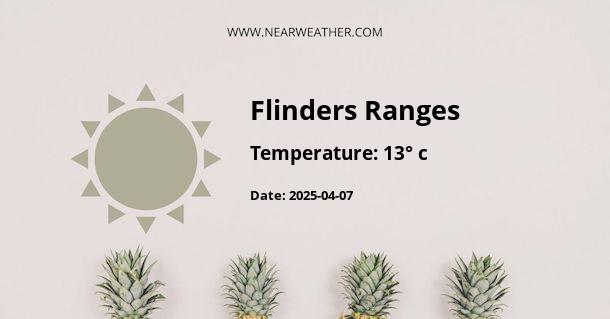Flinders Ranges, AU: Climate and Weather Overview
Located in South Australia, the Flinders Ranges is a stunning natural region that offers a diverse climate and varied weather conditions throughout the year. The climate of the Flinders Ranges is characterized by its arid and semi-arid conditions, with distinct seasonal changes and unique weather patterns.
Annual Weather Summary
The Flinders Ranges experiences a typical semi-arid climate, with hot, dry summers and cool to cold winters. The region receives a relatively low annual rainfall, with most of it occurring during the winter months. The variation in temperature and precipitation creates a dramatic and captivating landscape that is a sight to behold for visitors.
Seasonal Weather Patterns
Summer (December - February)
During the summer months, the Flinders Ranges experience hot and dry weather, with temperatures often exceeding 40°C (104°F) during the day. The nights can bring some relief with cooler temperatures, making it a popular time for visitors to explore the region's natural beauty.
Autumn (March - May)
Autumn in the Flinders Ranges brings relatively mild temperatures, making it a pleasant time to visit. The days are warm, and the nights start to become cooler as the season progresses. The region's iconic flora and fauna start to display beautiful autumnal colors, creating a picturesque backdrop for travelers.
Winter (June - August)
Winters in the Flinders Ranges are characterized by cool to cold temperatures, with occasional frost in the early morning. The region receives most of its annual rainfall during this season, rejuvenating the landscape and providing ideal conditions for outdoor activities such as hiking and birdwatching.
Spring (September - November)
Spring heralds the arrival of milder temperatures and the blooming of wildflowers, transforming the Flinders Ranges into a colorful wonderland. The days become warmer, and the region is teeming with life as the flora and fauna emerge from the winter months.
Temperature and Precipitation
The table below provides an overview of the average temperature and precipitation in the Flinders Ranges throughout the year:
| Month | Average High (°C) | Average Low (°C) | Precipitation (mm) |
|---|---|---|---|
| January | 34 | 18 | 13 |
| February | 33 | 18 | 14 |
| March | 30 | 16 | 16 |
| April | 25 | 12 | 20 |
| May | 21 | 9 | 24 |
| June | 17 | 6 | 23 |
| July | 17 | 5 | 23 |
| August | 19 | 7 | 20 |
| September | 23 | 10 | 20 |
| October | 27 | 13 | 18 |
| November | 30 | 15 | 15 |
| December | 33 | 17 | 14 |
As reflected in the table, the Flinders Ranges experiences a significant drop in average temperatures and an increase in precipitation during the winter months, providing a contrast to the hot and dry conditions of the summer.
Extreme Weather Events
While the Flinders Ranges typically experiences steady weather patterns, occasional extreme weather events can occur. These may include heatwaves during the summer months and isolated heavy rainfall or thunderstorms during the winter. It's essential for visitors to stay informed about weather forecasts and be prepared for potential weather fluctuations when exploring the region.
Conclusion
The climate and weather in the Flinders Ranges offer a captivating blend of arid conditions, seasonal variations, and stunning natural landscapes. Whether it's the intense heat of summer, the mild temperatures of autumn, the refreshing rains of winter, or the vibrant blooms of spring, each season brings its own unique charm to this remarkable region.
For nature enthusiasts, adventurers, and anyone seeking to experience the beauty of Australia's outback, the Flinders Ranges stands as an intriguing and mesmerizing destination where the weather is an integral part of the overall experience.
A - Flinders Ranges's Latitude is -32.133411 & Longitude is 138.338821.
A - Weather in Flinders Ranges is 11° today.
A - Climate Conditions in Flinders Ranges shows clear sky today.
A - Humidity in Flinders Ranges is 87% today.
A - Wind speed in Flinders Ranges is 9 km/h, flowing at 171° wind direction. today.
